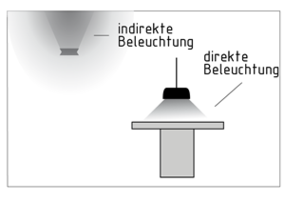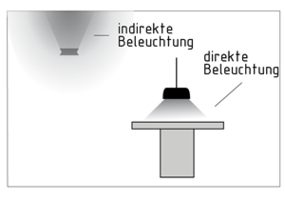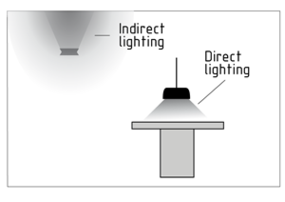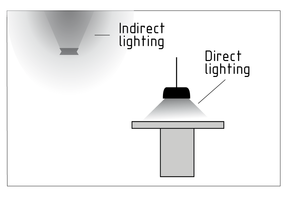
Seleccione uno
o más idiomas
0,1,3
- Alemán
- Inglés
- Chino
- Español
Iluminación

La iluminación da luz a los lugares de trabajo y encamina y crea condiciones de luz adecuadas para actividades específicas. Las fuentes de luz pueden ser artificiales o naturales, donde un sistema de luz optimizado pretende proporcionar una mezcla balanceada de ambos.
La iluminación es definida por colores, brillo y contraste. Un ambiente de trabajo eficiente y seguro puede considerarse iluminado de manera óptima cuando la luminancia (brillo) es pareja, y el color de la luz y la reproducción del color se asemejan a la luz natural. Es importante evitar el deslumbramiento, el parpadeo y las variaciones principales en el brillo.
Cuando se planea la iluminación del lugar de trabajo, una de 10:3:1 hace la diferencia entre un área central optimizada para el trabajo clave y un área circundante adjunta y general. La iluminancia (intensidad de iluminación) debe ser al menos de 100 lux en áreas de circulación y corredores, y de 1,500 lux en el caso de actividades de revisión y ajuste.
Los siguientes parámetros fotométricos básicos deben considerarse cuando se planea la iluminación: , , , , contraste, coeficiente de reflexión y eficiencia luminosa. Una buena iluminación tendrá el color más neutral posible.
Iluminación directa e indirecta
Beleuchtung

Die Beleuchtung erhellt Arbeitsstätte und Wege und schafft die geeigneten Lichtverhältnisse für die jeweiligen Tätigkeiten. Die Lichtquellen können künstlich oder natürlich sein, wobei eine optimierte Beleuchtung eine ausgewogene Mischung beider Lichtquellentypen anstrebt.
Die Beleuchtung wird von Farben, Helligkeit und Kontrast bestimmt. Eine effiziente und sichere Arbeitsumgebung ist optimal beleuchtet, wenn ausgewogene Lichtdichteverhältnisse vorherrschen und Lichtfarbe sowie Farbwiedergabe dem natürlichen Licht ähneln. Blendung, Flimmern und große Helligkeitsunterschiede müssen vermieden werden.
Bei der Planung der Arbeitsplatzbeleuchtung werden im Leuchtdichteverhältnis 10:3:1 der optimierte Kernbereich für wesentliche Arbeiten, ein angrenzender und ein allgemeiner Umgebungsbereich unterschieden. Die Beleuchtungsstärke beträgt mindestens 100 Lux für Verkehrsflächen und Flure und erreicht bei Prüf- und Justiertätigkeiten 1.500 Lux.
Für die Planung sind die lichttechnischen Grundgrößen Beleuchtungsstärke, Lichtstrom, Lichtstärke, Leuchtdichte, Kontrast, Reflexionsgrad und Lichtausbeute ausschlaggebend. Eine gute Beleuchtung ist möglichst farbneutral.
Lighting

Lighting illuminates workplaces and routes and creates suitable light conditions for specific activities. The light sources can be artificial or natural, whereby an optimised lighting system aims to deliver a balanced mix of both.
Lighting is defined by colours, brightness and contrast. An efficient and safe working environment can be considered optimally lit when Luminance (brightness) is even and the Light colour and colour reproduction resemble natural light. It is important to avoid glare, flickering and major variations in brightness.
When planning workplace lighting, a luminance ratio of 10:3:1 differentiates between the optimised core area for key Work and an adjoining and general surrounding area. The Illuminance (lighting Strength) must be at least 100 lux in circulation areas and corridors and 1,500 lux in the case of checking and adjusting activities.
The following basic photometric parameters must be taken into account when planning lighting: illuminance, Luminous flux, Luminous intensity, luminance, contrast, reflection coefficient and luminous efficacy. Good lighting will be as colour neutral as possible.
照明

照明设备对工作场所和道路进行照明,为具体活动创造适宜的光照条件。该光源可以是人造的或天然的,优化照明系统的目的是提供这两者的平衡混合。
根据色彩、亮度和对比度来定义照明。如果发光率(亮度)均匀、灯光色彩和色复现类似自然光,最佳照明可以视为一个高效、安全的工作环境。避免眩光、闪烁和主要亮度变化是很重要的。
当规划工作场所照明时,视野中观看主要工作核心区域、其贴邻的周围区域和总体背景之间的优化亮度比为 10: 3: 1。流通区域和走廊的照度(照明强度)至少须为 100 勒克斯,进行检查和调整活动的区域照度(照明强度)至少须为 1500 勒克斯。
规划工作场所照明时必须考虑以下基本光度参数:照度、光通量、发光强度、亮度、对比度、反射系数和发光效率。良好的照明最好选择中性色。
直接照明和间接照明
